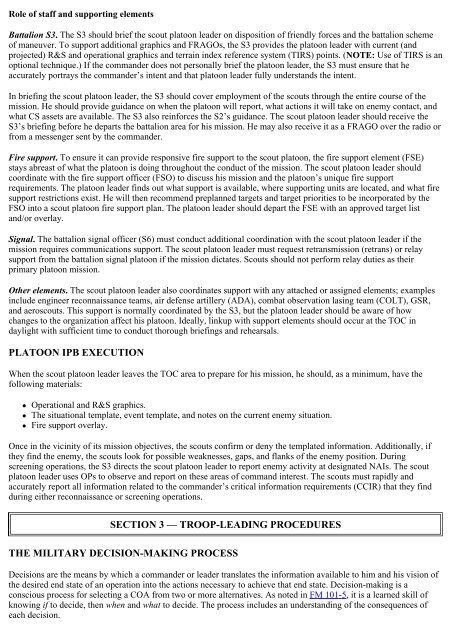FM 17-98 SCOUT PLATOON
FM 17-98 SCOUT PLATOON
FM 17-98 SCOUT PLATOON
Create successful ePaper yourself
Turn your PDF publications into a flip-book with our unique Google optimized e-Paper software.
Role of staff and supporting elements<br />
Battalion S3. The S3 should brief the scout platoon leader on disposition of friendly forces and the battalion scheme<br />
of maneuver. To support additional graphics and FRAGOs, the S3 provides the platoon leader with current (and<br />
projected) R&S and operational graphics and terrain index reference system (TIRS) points. (NOTE: Use of TIRS is an<br />
optional technique.) If the commander does not personally brief the platoon leader, the S3 must ensure that he<br />
accurately portrays the commander’s intent and that platoon leader fully understands the intent.<br />
In briefing the scout platoon leader, the S3 should cover employment of the scouts through the entire course of the<br />
mission. He should provide guidance on when the platoon will report, what actions it will take on enemy contact, and<br />
what CS assets are available. The S3 also reinforces the S2’s guidance. The scout platoon leader should receive the<br />
S3’s briefing before he departs the battalion area for his mission. He may also receive it as a FRAGO over the radio or<br />
from a messenger sent by the commander.<br />
Fire support. To ensure it can provide responsive fire support to the scout platoon, the fire support element (FSE)<br />
stays abreast of what the platoon is doing throughout the conduct of the mission. The scout platoon leader should<br />
coordinate with the fire support officer (FSO) to discuss his mission and the platoon’s unique fire support<br />
requirements. The platoon leader finds out what support is available, where supporting units are located, and what fire<br />
support restrictions exist. He will then recommend preplanned targets and target priorities to be incorporated by the<br />
FSO into a scout platoon fire support plan. The platoon leader should depart the FSE with an approved target list<br />
and/or overlay.<br />
Signal. The battalion signal officer (S6) must conduct additional coordination with the scout platoon leader if the<br />
mission requires communications support. The scout platoon leader must request retransmission (retrans) or relay<br />
support from the battalion signal platoon if the mission dictates. Scouts should not perform relay duties as their<br />
primary platoon mission.<br />
Other elements. The scout platoon leader also coordinates support with any attached or assigned elements; examples<br />
include engineer reconnaissance teams, air defense artillery (ADA), combat observation lasing team (COLT), GSR,<br />
and aeroscouts. This support is normally coordinated by the S3, but the platoon leader should be aware of how<br />
changes to the organization affect his platoon. Ideally, linkup with support elements should occur at the TOC in<br />
daylight with sufficient time to conduct thorough briefings and rehearsals.<br />
<strong>PLATOON</strong> IPB EXECUTION<br />
When the scout platoon leader leaves the TOC area to prepare for his mission, he should, as a minimum, have the<br />
following materials:<br />
• Operational and R&S graphics.<br />
• The situational template, event template, and notes on the current enemy situation.<br />
• Fire support overlay.<br />
Once in the vicinity of its mission objectives, the scouts confirm or deny the templated information. Additionally, if<br />
they find the enemy, the scouts look for possible weaknesses, gaps, and flanks of the enemy position. During<br />
screening operations, the S3 directs the scout platoon leader to report enemy activity at designated NAIs. The scout<br />
platoon leader uses OPs to observe and report on these areas of command interest. The scouts must rapidly and<br />
accurately report all information related to the commander’s critical information requirements (CCIR) that they find<br />
during either reconnaissance or screening operations.<br />
SECTION 3 — TROOP-LEADING PROCEDURES<br />
THE MILITARY DECISION-MAKING PROCESS<br />
Decisions are the means by which a commander or leader translates the information available to him and his vision of<br />
the desired end state of an operation into the actions necessary to achieve that end state. Decision-making is a<br />
conscious process for selecting a COA from two or more alternatives. As noted in <strong>FM</strong> 101-5, it is a learned skill of<br />
knowing if to decide, then when and what to decide. The process includes an understanding of the consequences of<br />
each decision.











